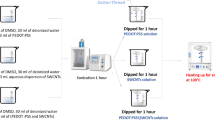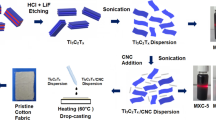Abstract
Simple and facile fabrication techniques to load conductive components onto textiles for wearable applications are highly demanded. In this work, highly conductive cotton fabrics were fabricated by dip-coating of single-walled carbon nanotubes (CNTs) after polydopamine (PDA) templating. The coated fabrics were characterized by scanning electron microscopy, X-ray photoelectron spectroscopy and energy dispersive X-ray spectrum. The introduction of PDA enhanced the adhesion between fiber surface and the loaded CNTs, resulting in a conductivity of 41.5 Ω/sq for the coated fabrics. The CNT-PDA-cotton fabric showed great durability against repeated mechanical deformation (bending, folding) or multiple washing cycles. The excellent strain sensing performance of the coated fabrics granted them the application potential in real-time monitoring of different human motions such as speaking, drinking, walking, bending of finger and knee etc. Furthermore, the composite fabrics showed outstanding electric heating performance with a rise in the surface temperature to about 120 °C within 20 s at 6 V. The fabrication of CNT-PDA-cotton composite fabrics provides a novel and simple way of developing textile-based wearable electronics and heaters.










Similar content being viewed by others
References
Amjadi M et al (2014) Highly stretchable and sensitive strain sensor based on silver nanowire–elastomer nanocomposite. ACS Nano 8(5):5154–5163
Amjadi M et al (2016) Stretchable, skin-mountable, and wearable strain sensors and their potential applications: a review. Adv Func Mater 26(11):1678–1698
Cai G et al (2017) Flexible and wearable strain sensing fabrics. Chem Eng J 325:396–403
Cai G et al (2018) Large-scale production of highly stretchable CNT/cotton/spandex composite yarn for wearable applications. ACS Appl Mater Interfaces 10(38):32726–32735
Chen L, Guo Z (2018) A facile method to mussel-inspired superhydrophobic thiol-textiles@ polydopamine for oil/water separation. Colloids Surf A 554:253–260
Chen K et al (2017) Fabrication of core–shell Ag@ pDA@ HAp nanoparticles with the ability for controlled release of Ag+ and superior hemocompatibility. RSC Adv 7(47):29368–29377
Cheng Y et al (2015) A stretchable and highly sensitive graphene-based fiber for sensing tensile strain, bending, and torsion. Adv Mater 27(45):7365–7371
Di J et al (2016) Carbon-nanotube fibers for wearable devices and smart textiles. Adv Mater 28(47):10529–10538
Du D et al (2016) Graphene coated nonwoven fabrics as wearable sensors. J Mater Chem C 4(15):3224–3230
Hu Y et al (2018) A low-cost, printable, and stretchable strain sensor based on highly conductive elastic composites with tunable sensitivity for human motion monitoring. Nano Res 11(4):1938–1955
Jia X et al (2014) Adhesive polydopamine coated avermectin microcapsules for prolonging foliar pesticide retention. ACS Appl Mater Interfaces 6(22):19552–19558
Kang TJ et al (2010) Electromechanical properties of CNT-coated cotton yarn for electronic textile applications. Smart Mater Struct 20(1):015004
Karim N et al (2017) Scalable production of graphene-based wearable e-textiles. ACS Nano 11(12):12266–12275
Li L et al (2017a) Surface micro-dissolution process for embedding carbon nanotubes on cotton fabric as a conductive textile. Cellulose 24(2):1121–1128
Li Q et al (2017b) Reduced graphene oxide functionalized stretchable and multicolor electrothermal chromatic fibers. J Mater Chem C 5(44):11448–11453
Li X et al (2018) Wearable strain sensing textile based on one-dimensional stretchable and weavable yarn sensors. Nano Res 11(11):5799–5811
Li T et al (2019) Materials, structures, and functions for flexible and stretchable biomimetic sensors. Acc Chem Res 52(2):288–296
Liu Y et al (2008) Functionalization of cotton with carbon nanotubes. J Mater Chem 18(29):3454–3460
Liu Y et al (2015) One-step modification of fabrics with bioinspired polydopamine@ octadecylamine nanocapsules for robust and healable self-cleaning performance. Small 11(4):426–431
MohanáKumar G (2015) Highly efficient CNT functionalized cotton fabrics for flexible/wearable heating applications. RSC Adv 5(14):10697–10702
Molina J (2016) Graphene-based fabrics and their applications: a review. RSC Adv 6(72):68261–68291
Qiao Y et al (2018) Multilayer graphene epidermal electronic skin. ACS Nano 12(9):8839–8846
Ryu S et al (2015) Extremely elastic wearable carbon nanotube fiber strain sensor for monitoring of human motion. ACS Nano 9(6):5929–5936
Samad YA et al (2017) From sewing thread to sensor: Nylon® fiber strain and pressure sensors. Sens Actuators B Chem 240:1083–1090
Seyedin S et al (2019) Textile strain sensors: a review of the fabrication technologies, performance evaluation and applications. Mater Horizons 6(2):219–249
Shim BS et al (2008) Smart electronic yarns and wearable fabrics for human biomonitoring made by carbon nanotube coating with polyelectrolytes. Nano Lett 8(12):4151–4157
Wang C et al (2016a) Carbonized silk fabric for ultrastretchable, highly sensitive, and wearable strain sensors. Adv Mater 28(31):6640–6648
Wang Z et al (2016b) Polyurethane/cotton/carbon nanotubes core-spun yarn as high reliability stretchable strain sensor for human motion detection. ACS Appl Mater Interfaces 8(37):24837–24843
Wang Y et al (2018) Ultra-stretchable, sensitive and durable strain sensors based on polydopamine encapsulated carbon nanotubes/elastic bands. J Mater Chem C 6(30):8160–8170
Yan C et al (2014) Highly stretchable piezoresistive graphene–nanocellulose nanopaper for strain sensors. Adv Mater 26(13):2022–2027
Yan D et al (2016) Polydopamine nanotubes: bio-inspired synthesis, formaldehyde sensing properties and thermodynamic investigation. J Mater Chem A 4(9):3487–3493
Yang M et al (2018a) Conductive cotton fabrics for motion sensing and heating applications. Polymers 10(6):568
Yang Z et al (2018b) Graphene textile strain sensor with negative resistance variation for human motion detection. ACS Nano 12(9):9134–9141
Yin B et al (2017) Highly stretchable, ultrasensitive, and wearable strain sensors based on facilely prepared reduced graphene oxide woven fabrics in an ethanol flame. ACS Appl Mater Interfaces 9(37):32054–32064
Zeng W et al (2014) Fiber-based wearable electronics: a review of materials, fabrication, devices, and applications. Adv Mater 26(31):5310–5336
Zeng L et al (2018) Macroscale porous carbonized polydopamine-modified cotton textile for application as electrode in microbial fuel cells. J Power Sources 376:33–40
Author information
Authors and Affiliations
Corresponding authors
Additional information
Publisher's Note
Springer Nature remains neutral with regard to jurisdictional claims in published maps and institutional affiliations.
Rights and permissions
About this article
Cite this article
Sadi, M.S., Pan, J., Xu, A. et al. Direct dip-coating of carbon nanotubes onto polydopamine-templated cotton fabrics for wearable applications. Cellulose 26, 7569–7579 (2019). https://doi.org/10.1007/s10570-019-02628-1
Received:
Accepted:
Published:
Issue Date:
DOI: https://doi.org/10.1007/s10570-019-02628-1




